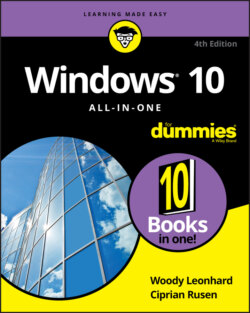Читать книгу Windows 10 All-in-One For Dummies - Ciprian Adrian Rusen, Woody Leonhard - Страница 24
What is the World Wide Web?
ОглавлениеPeople tend to confuse the World Wide Web with the Internet, which is much like confusing the dessert table with the buffet line. I’d be the first to admit that desserts are mighty darn important — life-critical, in fact, if the truth be told. But they aren’t the same as the buffet line.
To get to the dessert table, you must stand in the buffet line. To get to the web, you have to be running on the Internet. Make sense?
The World Wide Web owes its existence to Tim Berners-Lee and a few co-conspirators at a research institute named CERN in Geneva, Switzerland. In 1990, Berners-Lee demonstrated a way to store and link information on the Internet so that all you had to do was click to jump from one place — one web page — to another. Nowadays, nobody in his right mind can give a definitive count of the number of pages available, but in 2016, Google reported that it had indexed more than 130 trillion pages. Since then, that number has surely exploded to many hundreds of trillions. Like the Internet itself, the World Wide Web owes much of its success to the brilliance of the people who brought it to life. The following list describes the ground rules:
Web pages, stored on the Internet, are identified by an address, such as
www.dummies.com. The main part of the web page address — dummies.com, for example — is a domain name. With rare exceptions, you can open a web page by typing its domain name and pressing Enter. Spelling counts, and underscores (_) are treated differently from hyphens (-). Being close isn’t good enough — there are just too many websites. The part after the dot is the top-level domain. According to VeriSign, in June 2017, approximately 331.9 million domains were on the Internet, with top-level domains such as .com, .net, .org, .info, .biz, or .us. This statistic included all countries and country-specific top-level domains, such as co.uk (the UK equivalent of .com,) .br for Brazil, and .jp for Japan.Web pages are written in the funny language HyperText Markup Language (HTML). HTML is sort of a programming language, sort of a formatting language, and sort of a floor wax, all rolled into one. Many products claim to make it easy for novices to create powerful, efficient HTML. Some of those products are getting close.
To read a web page, you must use a web browser. A web browser is a program or desktop app that runs on your computer and is responsible for converting HTML into text that you can read and use. Many people who view web pages use Google’s Chrome web browser, although Mozilla Firefox, Opera, and Microsoft’s Edge browser in Windows 10 are all contenders. Internet Explorer is still inside Windows 10, but you have to dig deep to find it. (Hint: Click the Start icon and then open Windows Accessories.) Internet Explorer is no longer actively maintained by Microsoft, and their plan is to convince people to use Microsoft Edge. If you don’t stick to the dated and insecure Internet Explorer, any web browser is a good choice.
More and more people (including me!) prefer Mozilla Firefox (see
www.mozilla.org), Opera (seewww.opera.com), or Chrome, from Google (www.google.com/chrome). You may not know that Firefox and Chrome can run right alongside Internet Explorer and Microsoft Edge, with absolutely no confusion between the two. Err, four. In fact, they don’t even interact — Microsoft Edge, Firefox, and Google Chrome were designed to operate completely independently, and they do not mess with each other in any way, except when trying to promote themselves over their competitors.
One unwritten rule for the World Wide Web: All web acronyms must be completely, utterly inscrutable. For example, a web address is a Uniform Resource Locator, or URL. (The techies I know pronounce URL “earl.” Those who don’t wear white lab coats tend to say “you are ell.”) As I said earlier, the HTML acronym means HyperText Markup Language. On the web, a gorgeous, sunny, palm-lined beach with the scent of frangipani wafting through the air would no doubt be called SHS — Smelly Hot Sand. Sheeesh.
The best part of the web is how easily you can jump from one place to another — and how easily you can create web pages with hot links (also called hyperlinks or just links) that transport the viewer wherever the author intends. That’s the H in HTML and the original reason for creating the web so many years ago.
